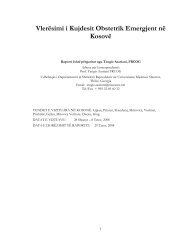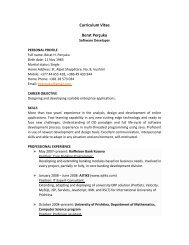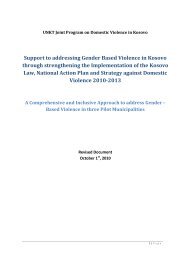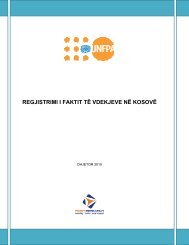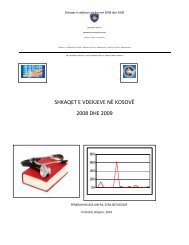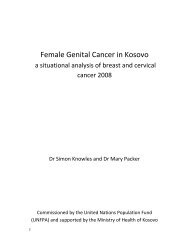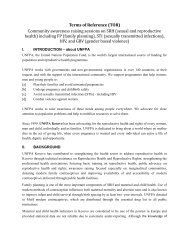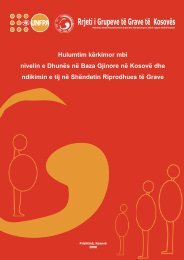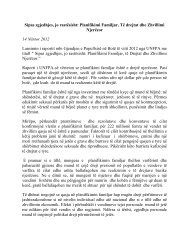perinatal situation in kosovo for years 2000 â 2004 - UNFPA
perinatal situation in kosovo for years 2000 â 2004 - UNFPA
perinatal situation in kosovo for years 2000 â 2004 - UNFPA
You also want an ePaper? Increase the reach of your titles
YUMPU automatically turns print PDFs into web optimized ePapers that Google loves.
PERINATAL SITUATION IN KOSOVO<br />
FOR YEARS <strong>2000</strong> – <strong>2004</strong><br />
September 2005<br />
UNMIK<br />
M<strong>in</strong>istry of Health<br />
WHO
Report prepared by:<br />
Prof. asc. dr. Shefqet Lulaj, President of Kosovo Mother and Child Health Council<br />
Dr. Agron Gashi, Programme Officer, Health and Nutrition Unit, UNICEF – Kosovo<br />
Office<br />
Dr. Lulzim Çela, Mother and Child Health Officer, M<strong>in</strong>istry of Health<br />
Dr. Skender Syla, Act<strong>in</strong>g Head of Office, WHO<br />
Dr. Syheda Latifi – Hoxha, Chief of maternity ward <strong>in</strong> GYN/OBS Cl<strong>in</strong>ic <strong>in</strong> Prisht<strong>in</strong>a<br />
Dr. Mynevere Hoxha, Chief of Neonatology Unit <strong>in</strong> GYN/OBS Cl<strong>in</strong>ic <strong>in</strong> Prisht<strong>in</strong>a<br />
Prof. Assoc. Dr. Mujë Shala, Chief of Centre <strong>for</strong> preterm newborns and neonatology <strong>in</strong><br />
Prisht<strong>in</strong>a<br />
Prof. Assoc. Dr. Merita Koq<strong>in</strong>aj-Berisha, National Institute of Public Health<br />
Dr. Visare Mujko – Nimani, National Professional Officer, <strong>UNFPA</strong><br />
Dr. Njazi Shala, President of Kosovo Pediatric Association<br />
Prof. ass. dr. Sejdullah Hoxha, President of Kosovo Gynecology and Obstetric<br />
Association<br />
Pr<strong>in</strong>t<strong>in</strong>g of the report was supported by the UNICEF Kosovo Office.<br />
i
Table of Contents<br />
Acknowledgment................................................................................................. iv<br />
Executive Summary ............................................................................................. 1<br />
Introduction ........................................................................................................ 2<br />
Per<strong>in</strong>atal data <strong>for</strong> <strong>years</strong> <strong>2000</strong> – <strong>2004</strong>..................................................................... 4<br />
Methodology....................................................................................................... 4<br />
Ma<strong>in</strong> Per<strong>in</strong>atal Indicators <strong>in</strong> Kosovo........................................................................ 5<br />
Human Resources................................................................................................ 6<br />
Medial Equipment ................................................................................................ 6<br />
Reported number of deliveries <strong>for</strong> <strong>years</strong> <strong>2000</strong> – <strong>2004</strong> .............................................. 7<br />
Per<strong>in</strong>atal Mortality Rate <strong>for</strong> <strong>years</strong> <strong>2000</strong> – <strong>2004</strong> ....................................................... 9<br />
Stillbirth Rate <strong>for</strong> <strong>years</strong> <strong>2000</strong> – <strong>2004</strong>....................................................................12<br />
Early Neonatal Mortality Rates <strong>for</strong> <strong>years</strong> <strong>2000</strong> – <strong>2004</strong> ............................................14<br />
Maternal Mortality Ratio ......................................................................................14<br />
Recommendations ..............................................................................................19<br />
Annex 1. KOSOVO MATERNITY ACTIVITY, <strong>2000</strong> – 2001 – 2002 – 2003 – <strong>2004</strong>.....21<br />
Annex 2. KOSOVO MATERNITY ACTIVITY, JANUARY – DECEMBER <strong>2004</strong> ...............22<br />
References ........................................................................................................23<br />
ii
Map of maternities <strong>in</strong> Kosovo 1<br />
1<br />
Currently adm<strong>in</strong>istered by the United Nations pursuant to Security Council Resolution 1244<br />
iii
Acknowledgment<br />
The Per<strong>in</strong>atal report was prepared by the group of authors and with support of<br />
Dr.Ramadan Halimi, Dr.Sami Rexhepi, Dr.Ali Berisha, Dr.Adem Nura, Dr.Pal Lekaj,<br />
Dr.Jakup Dobraja, Ms.Shpresa Ajazi, Ms. Sabile Namani, Dr.Curr Gjocaj, Dr.Drita Fazliu,<br />
Ms.Halime Klisurica, Morrocian Hospital, Dr.Blerim Feka, Dr.Agim Zahiti, Ms.Shemsije<br />
Kutllovci, Dr.Ismet Miftari, Dr.Ibrahim Rexha, Dr.Lumturije Muja, Dr.Qelë Alijaj,<br />
Dr.Ahmet Dukaj, Dr.Ahmet Asllani, Dr.Mërgime Batusha, Dr.Adem Kafexholli,<br />
Dr.Fëllanza Gjergjizi, Dr.Shahzije Vuçitërna, Dr.Adem Halitaj, Dr.Fehmi Bojaxhiu,<br />
Dr.Tefik Dërmaku, Dr.Bajram Syla, Dr.Reshat Sokoli, Dr.Zeqir Gërbeshi, Dr.Njazi Luma<br />
and other health workers that have actively participated <strong>in</strong> data collection and have<br />
supported dur<strong>in</strong>g all the process of data collection.<br />
We would like to use this opportunity and to express our s<strong>in</strong>cere acknowledgment and<br />
gratitude <strong>for</strong> their active support and understand<strong>in</strong>g.<br />
We do hope that this report will be helpful <strong>for</strong> further programme plann<strong>in</strong>g <strong>in</strong> mother<br />
and child health field, fill the exist<strong>in</strong>g data gap and determ<strong>in</strong>e the basel<strong>in</strong>e mother and<br />
child healthy vital <strong>in</strong>dicators.<br />
iv
Executive Summary<br />
One of the major challenges <strong>for</strong> Kosovo medical society and International organizations<br />
is improvement of the health population status <strong>in</strong> particular mother and child health<br />
<strong>situation</strong>.<br />
Six <strong>years</strong> after the end of the conflict the f<strong>in</strong>al Kosovo status is still not determ<strong>in</strong>ed and<br />
there is a lack of accurate demographic and other health <strong>in</strong>dicators data.<br />
Lack of the mother and child health vital <strong>in</strong>dicators still rema<strong>in</strong>s as one of the ma<strong>in</strong><br />
issues. This report attempt to present and evaluate the <strong>per<strong>in</strong>atal</strong> <strong>situation</strong> <strong>in</strong> Kosovo<br />
from year <strong>2000</strong> to <strong>2004</strong>.<br />
The <strong>in</strong><strong>for</strong>mation where extracted from the delivery room and neonatal unit logbooks.<br />
The record<strong>in</strong>g <strong>for</strong>ms were distributed prior to the relevant staff <strong>in</strong> maternities. The data<br />
were collected also from Neonatal Unit of Pediatric Cl<strong>in</strong>ic <strong>in</strong> Prisht<strong>in</strong>a <strong>for</strong> the number of<br />
newborns refereed and early neonatal deaths. Data from Gynecology and Obstetric<br />
ward of Mitrovica North Hospital and Graqanica are not reported regularly. There were<br />
no data collected on home deliveries or deliveries <strong>in</strong> private cl<strong>in</strong>ics.<br />
Def<strong>in</strong>itions and Indicators are based on the Family Plann<strong>in</strong>g, Maternal and Child Health<br />
and Reproductive Health, used <strong>in</strong> the WHO Regional Office <strong>for</strong> Europe.<br />
Ma<strong>in</strong> Per<strong>in</strong>atal Indicators <strong>in</strong> Kosovo <strong>for</strong> <strong>years</strong> <strong>2000</strong> – <strong>2004</strong> are given <strong>in</strong> follow<strong>in</strong>g table:<br />
<strong>2000</strong> 2001 2002 2003 <strong>2004</strong><br />
Total number of<br />
deliveries<br />
Total number of<br />
alive newborns<br />
Total number of<br />
stillbirths<br />
39 091 39 578 35 399 31 932 30 925<br />
38 907 39 506 35 271 31 815 30 852<br />
572 579 527 517 452<br />
Stillbirths rate 14.5 14.4 14.7 15.9 14.4<br />
Total number of<br />
neonatal deaths<br />
Early neonatal<br />
mortality rate<br />
Per<strong>in</strong>atal mortality<br />
rate<br />
Caesarean section<br />
rate<br />
577 574 444 375 352<br />
1.48 1.45 1.26 11.8 11.4<br />
29.1 per<br />
1000<br />
28.7 per<br />
1000<br />
27.1 per<br />
1000<br />
27.6 per<br />
1000<br />
25.6 per<br />
1000<br />
7.5 9.1 10.3 11.3 12.3<br />
Sex ratio 1.08 1.09 1.06 N/A 1.06<br />
1
Introduction<br />
In 1999, Kosovo came under the adm<strong>in</strong>istration of the United Nations Mission <strong>in</strong><br />
Kosovo - UNMIK <strong>in</strong> partnership with the European Union (EU) and the Organization <strong>for</strong><br />
Security and Cooperation <strong>in</strong> Europe (OSCE).<br />
Kosovo covers an area of 10.908 km 2 and its population is 2.1 million accord<strong>in</strong>g to the<br />
projections by UNMIK <strong>for</strong> <strong>2000</strong> elections. Although accurate data is not available<br />
estimated age breakdown of the population is given <strong>in</strong> Table 1 below:<br />
Table 1. General population figures by age groups <strong>in</strong> Kosovo, <strong>2000</strong><br />
Total<br />
population<br />
Population aged<br />
less than 15<br />
<strong>years</strong><br />
Population aged<br />
less than 5<br />
<strong>years</strong><br />
Population<br />
aged less than<br />
1 year<br />
Number of<br />
persons<br />
Percentage of<br />
Total<br />
population<br />
2.105.000 736.750 252.600 46.310<br />
100 % 35 % 12 % 2.2 %<br />
Kosovo is characterized by a lack of accurate demographic data. The last commonly<br />
accepted census <strong>in</strong> Kosovo took place <strong>in</strong> 1981. Based on estimates Kosovo has a<br />
population of over 2 million.<br />
The maternal, <strong>per<strong>in</strong>atal</strong>, <strong>in</strong>fant and child health status of Kosovo’s women and children<br />
is poor compared to the rest of Europe. The high maternal, <strong>per<strong>in</strong>atal</strong> and <strong>in</strong>fant mortality<br />
rates reflect the need to improve the accessibility, utilization and quality of services <strong>for</strong><br />
the prevention, detection and treatment of the health problems that occur dur<strong>in</strong>g<br />
pregnancy, childbirth and <strong>in</strong>fancy.<br />
The <strong>in</strong>fant mortality rate (IMR) is estimated at 49 per 1,000 live births (Demographic<br />
and Health Survey – DHS 2003) while under 5 mortality rate is 69 per 1000. Per<strong>in</strong>atal<br />
mortality rate <strong>for</strong> year <strong>2004</strong> is 25.6 per 1000 show<strong>in</strong>g decl<strong>in</strong>e trend from 29.1 <strong>for</strong><br />
1000 <strong>in</strong> year <strong>2000</strong>.<br />
Average growth rate is estimated to be 2.01%. It is also estimated that 26% of the<br />
population are women of childbear<strong>in</strong>g age.<br />
The population of Kosovo is young, with a mean age of 25 <strong>years</strong>. Over half of the<br />
population is under 25 <strong>years</strong> of age and only eight per cent is over 60. Women of<br />
childbear<strong>in</strong>g age (15-45 <strong>years</strong>) constitute 56% of the female population. The average<br />
number of people per household is 7.<br />
In year <strong>2000</strong> issued UNMIK Regulation No. <strong>2000</strong>/10 authorized the <strong>for</strong>mer Department<br />
of Health and Social Welfare to develop policies <strong>for</strong> health. Based on this, the<br />
Department of Health has issued the “Health Policy <strong>for</strong> Kosovo - 2001” to guide the<br />
development of Kosovo’s health care and the first objective of the policy is Health Start<br />
<strong>in</strong> Life.<br />
Economically, Kosovo is one of the least developed and poorest regions <strong>in</strong> Europe. The<br />
lack of economic development also impacts the health sector, with most <strong>in</strong>dicators not<br />
<strong>in</strong> l<strong>in</strong>e with developed countries. The Gross Domestic Product (GDP) per capita <strong>in</strong> 2003<br />
is 790 USD. Recent World Bank data show that the number of people liv<strong>in</strong>g <strong>in</strong> absolute<br />
2
poverty has <strong>in</strong>creased from 12 per cent <strong>in</strong> <strong>2000</strong> to 15 per cent <strong>in</strong> 2003. Unemployment<br />
is very high, with 57 per cent of the available work<strong>for</strong>ce out of work. It is particularly<br />
concentrated among women and young people who have levels of close to 70 per cent.<br />
Per<strong>in</strong>atal mortality records deaths occurr<strong>in</strong>g dur<strong>in</strong>g late pregnancy (after 22 weeks<br />
gestation), at birth and dur<strong>in</strong>g the first week of life (0-6 days). The poor report<strong>in</strong>g of<br />
vital events by the health <strong>in</strong>stitutions renders it difficult to estimate the <strong>per<strong>in</strong>atal</strong><br />
mortality reliably. WHO, UNICEF and <strong>UNFPA</strong> have tried to solve the problem by<br />
collect<strong>in</strong>g and analyz<strong>in</strong>g data on <strong>per<strong>in</strong>atal</strong> <strong>in</strong>dicators s<strong>in</strong>ce <strong>2000</strong>. The report does not<br />
cover deliveries at home or <strong>in</strong> the private cl<strong>in</strong>ics.<br />
The recorded <strong>per<strong>in</strong>atal</strong> rate was 29.2 <strong>in</strong> <strong>2000</strong> while <strong>for</strong> year <strong>2004</strong> is 25.6 per 1.000<br />
births. Although there is a decl<strong>in</strong>e trend the figures are far too high from the Western<br />
Europe countries and this need to be expla<strong>in</strong>ed and addressed properly by specific<br />
studies and one of the possible causes may be <strong>in</strong>adequate level of the antenatal care.<br />
The development of <strong>per<strong>in</strong>atal</strong> mortality over the past four <strong>years</strong> is characterized by a<br />
steady stillbirth rate and a slightly decreas<strong>in</strong>g <strong>per<strong>in</strong>atal</strong> and early neonatal mortality<br />
rates suggest<strong>in</strong>g that the further educational and cl<strong>in</strong>ical ef<strong>for</strong>ts and support <strong>in</strong> needed<br />
to improve the quality of obstetric and neonatal care <strong>in</strong> Kosovo.<br />
In year <strong>2004</strong> M<strong>in</strong>istry of Health <strong>in</strong> row of previous organized conferences by the WHO<br />
and UNICEF <strong>in</strong> collaboration with Kosovo Mother and Child Health Council, Kosovo<br />
Gynaecology Association and Kosovo Paediatric Association and supported by UNICEF<br />
Kosovo Office has organised a Per<strong>in</strong>atal Conference.<br />
In year 2005 M<strong>in</strong>istry of Health supported by Swiss Red Cross/UNFAP <strong>in</strong> collaboration<br />
with other relevant <strong>in</strong>stitutions and organization have created a work<strong>in</strong>g group <strong>for</strong><br />
development and completed the Reproductive Health Strategy and currently is <strong>in</strong> the<br />
f<strong>in</strong>al stage <strong>for</strong> f<strong>in</strong>aliz<strong>in</strong>g the Reproductive Healthy Law.<br />
World Health Day 2005 was focused on maternal and child health with motto “Make<br />
Every Mother and Child account”. For this purpose was organized <strong>in</strong> Kosovo a<br />
campaign and conference leaded by the M<strong>in</strong>istry of Health - Mother and Child Health<br />
Office <strong>in</strong> collaboration with different relevant <strong>in</strong>stitutions and very actively supported by<br />
WHO, UNICEF and <strong>UNFPA</strong>. This conference gathered government stakeholders,<br />
organizations, professionals and local society and enabled presentation of the Per<strong>in</strong>atal<br />
<strong>situation</strong> <strong>in</strong> year <strong>2004</strong>, launch<strong>in</strong>g of the different publications and f<strong>in</strong>al draft of<br />
Pregnancy and Child Health booklets. The conference was successful and Mr. Sadik<br />
Idrizi, M<strong>in</strong>ister of Health declared year 2005 the Mother and Child Year <strong>in</strong> Kosovo.<br />
3
Per<strong>in</strong>atal data <strong>for</strong> <strong>years</strong> <strong>2000</strong> – <strong>2004</strong><br />
Methodology<br />
In order to evaluate the <strong>per<strong>in</strong>atal</strong> <strong>situation</strong> <strong>in</strong> Kosovo <strong>in</strong> year <strong>2000</strong> the WHO Mother and<br />
Child Health unit <strong>in</strong> Kosovo has created a monthly report on maternal and neonatal<br />
activity record<strong>in</strong>g <strong>for</strong>m <strong>for</strong> collection of the data. These record<strong>in</strong>g <strong>for</strong>ms were<br />
distributed prior to the relevant staff <strong>in</strong> all maternities. The <strong>in</strong><strong>for</strong>mation where extracted<br />
and reported from the delivery room and neonatal unit logbooks. The data were<br />
collected also from the health facilities were deliveries occurred even they are not<br />
endorsed as maternities. The data were collected also from the Neonatal Unit of<br />
Pediatric Cl<strong>in</strong>ic <strong>in</strong> Prisht<strong>in</strong>a <strong>for</strong> the number of newborns refereed and early neonatal<br />
deaths. There were no data collected on home deliveries or deliveries <strong>in</strong> private cl<strong>in</strong>ics.<br />
With aim to obta<strong>in</strong> overall and accurate <strong>per<strong>in</strong>atal</strong> mortality data, neonatal deaths<br />
occurred <strong>in</strong> Prisht<strong>in</strong>a Neonatal Unit are attributed to the refered maternities.<br />
In year 2001 UNICEF Kosovo Office has jo<strong>in</strong>ed and dur<strong>in</strong>g these <strong>years</strong> leaded and<br />
supported collection and analys<strong>in</strong>g process of the <strong>per<strong>in</strong>atal</strong> <strong>in</strong>dicators. The process of<br />
data collection and analysis process cont<strong>in</strong>ued actively supported by the health<br />
professionals, Kosovo Mother and Child Health Council, Kosovo Gynecology<br />
Association and Kosovo Pediatric Association. The collected data has filled the lack of<br />
vital <strong>in</strong>dicators and data collection process has followed the same methodology s<strong>in</strong>ce<br />
year <strong>2000</strong>.<br />
Def<strong>in</strong>itions and Indicators are based on the Family Plann<strong>in</strong>g, Maternal & Child Health &<br />
Reproductive Health, used <strong>in</strong> the WHO Regional Office <strong>for</strong> Europe.<br />
The results and <strong>in</strong>terpretation of data <strong>for</strong> the year <strong>2000</strong> – <strong>2004</strong> were as below:<br />
• Reported number of deliveries<br />
• Reported mode of delivery<br />
• Reported number of live births<br />
• Reported number of low birth weight babies<br />
• Reported number of stillbirths<br />
• Reported number of early neonatal deaths, and<br />
• Reported number of maternal deaths<br />
The follow<strong>in</strong>g <strong>in</strong>dicators were calculated us<strong>in</strong>g the reported data:<br />
• Per<strong>in</strong>atal Mortality Rate<br />
• Early Neonatal Mortality Rate<br />
• Stillbirths Rate<br />
• Maternal mortality ratio, and<br />
• Caesarean section Rate<br />
4
Ma<strong>in</strong> Per<strong>in</strong>atal Indicators <strong>in</strong> Kosovo<br />
In <strong>2000</strong>, there were reported 38 907 live births and 572 stillbirths delivered by 39 091<br />
mothers. There were 2 264 low birth weight babies and 577 early neonatal deaths. The<br />
Caesarean section rate was 7.5 %. N<strong>in</strong>e maternal death was reported; the maternal<br />
mortality ratio was 23 per 100 000 live births. The <strong>per<strong>in</strong>atal</strong> mortality rate was 29.1<br />
per 1000 of all births (29.1/1000).<br />
In 2001, there were reported 39 506 live births and 579 stillbirths delivered by 39 578<br />
mothers. There were 2 397 low birth weight babies and 574 early neonatal deaths. The<br />
Caesarean section rate was 9.1 %. Five maternal death was reported; the maternal<br />
mortality ratio was 12.6 per 100 000 live births. The <strong>per<strong>in</strong>atal</strong> mortality rate was 28.7<br />
per 1000 of all births (28.7/1000).<br />
In 2002, there were reported 35 271 live births and 527 stillbirths delivered by 35 399<br />
mothers. There were 2086 low birth weight babies and 444 early neonatal deaths. The<br />
Caesarean section rate was 10.3 %. None of maternal death was reported. The<br />
<strong>per<strong>in</strong>atal</strong> mortality rate was 27.1 per 1000 of all births (27.1/1000).<br />
In 2003, there were reported 31 815 live births and 517 stillbirths delivered by 31 932<br />
mothers. There were 2 155 low birth weight babies and 375 early neonatal deaths. The<br />
Caesarean section rate was 11.3 %. Seven maternal deaths were reported. The<br />
<strong>per<strong>in</strong>atal</strong> mortality rate was 27.6 per 1000 of all births (27.6/1000).<br />
In <strong>2004</strong>, there were reported 30 852 live births and 452 stillbirths delivered by 30 925<br />
mothers. There were 2 106 low birth weight babies and 352 early neonatal deaths. The<br />
Caesarean section rate was 12.34 %. Three maternal deaths are reported. The<br />
<strong>per<strong>in</strong>atal</strong> mortality rate is 25.68 per 1000 of all births (25.68/1000).<br />
Ma<strong>in</strong> Per<strong>in</strong>atal Indicators <strong>in</strong> Kosovo <strong>for</strong> <strong>years</strong> <strong>2000</strong>, 2001, 2002, 2003 and <strong>2004</strong> are<br />
given <strong>in</strong> follow<strong>in</strong>g table:<br />
<strong>2000</strong> 2001 2002 2003 <strong>2004</strong><br />
Total number of<br />
deliveries<br />
Total number of<br />
alive newborns<br />
Total number of<br />
stillbirths<br />
39 091 39 578 35 399 31 932 30 925<br />
38 907 39 506 35 271 31 815 30 852<br />
572 579 527 517 452<br />
Stillbirths rate 14.5 14.4 14.7 15.9 14.44<br />
Total number of<br />
neonatal deaths<br />
Early neonatal<br />
mortality rate<br />
Per<strong>in</strong>atal mortality<br />
rate<br />
Caesarean section<br />
rate<br />
577 574 444 375 352<br />
1.48 1.45 1.26 11.8 11.41<br />
29.1 per<br />
1000<br />
28.7 per<br />
1000<br />
27.1 per<br />
1000<br />
27.6 per<br />
1000<br />
27.09 per<br />
1000<br />
7.5 9.1 10.3 11.3 12.34<br />
Sex ratio 1.08 1.09 1.06 N/A 1.06<br />
5
Human Resources<br />
Dur<strong>in</strong>g year 2003 and <strong>2004</strong> were collected additional data from maternities regard<strong>in</strong>g<br />
the human resources. It is evident that the number of Gynecologist and Obstetricians is<br />
sufficient an even exceed<strong>in</strong>g the requirements. However the adequate distribution all<br />
over Kosovo is present and is affect<strong>in</strong>g fully function<strong>in</strong>g of some maternities because<br />
they don’t have or number of Gynecologist work<strong>in</strong>g <strong>in</strong> these maternities is limited<br />
mostly <strong>in</strong> primary health care services <strong>in</strong> places such as Podujeva, Viti, Gllogovc, Suha-<br />
Reka.<br />
Most severe issue is lack of Neonatologyst <strong>in</strong> tertiary and secondary health care levels<br />
and this need to be considered and addressed <strong>in</strong> future.<br />
The number of nurses and midwives is sufficient, however distribution is also required.<br />
The <strong>in</strong>adequate and lack of human resources skills is affect<strong>in</strong>g and overcrowd<strong>in</strong>g the<br />
Prisht<strong>in</strong>a Gynecology and Obstetric Cl<strong>in</strong>ics. Prisht<strong>in</strong>a Cl<strong>in</strong>ic yearly is per<strong>for</strong>m<strong>in</strong>g around<br />
12 000 deliveries. Vast of pregnant women are com<strong>in</strong>g from surround<strong>in</strong>g areas that<br />
have available maternities. The pregnant women are either self-refered or refered from<br />
maternities.<br />
In some maternities that are per<strong>for</strong>m<strong>in</strong>g high number of deliveries although they are<br />
possess<strong>in</strong>g good but <strong>in</strong>sufficient <strong>in</strong>frastructure, qualified health personnel, equipment<br />
they are fac<strong>in</strong>g lack of anestesiologyst which also affects and overload the Prisht<strong>in</strong>a<br />
Gynecology and Obstetric Cl<strong>in</strong>ic.<br />
Medial Equipment<br />
Beside the human resources and their skills the quality of the health care services is<br />
also affected from the adequate equipment.<br />
In general maternities are well equipped with basic obstetric equipment. However there<br />
is a lack of specific and high technology equipment <strong>in</strong> tertiary and secondary health<br />
care. There is a lack of <strong>in</strong>cubators <strong>in</strong> secondary health care levels while there are to<br />
many and unused <strong>in</strong> primary health care levels. This needs further evaluation and<br />
reallocation <strong>in</strong> places that have <strong>in</strong>adequate and <strong>in</strong>sufficient <strong>in</strong>cubators.<br />
There is a lack of equipment regard<strong>in</strong>g the <strong>in</strong>tensive neonatal care particularly <strong>in</strong><br />
Gynecology/Obstetric Cl<strong>in</strong>ic Neonatology Unit.<br />
6
Reported number of deliveries <strong>for</strong> <strong>years</strong> <strong>2000</strong> – <strong>2004</strong><br />
S<strong>in</strong>ce year <strong>2000</strong> the number of deliveries has shown decl<strong>in</strong>e trend. In year <strong>2000</strong>, there<br />
were reported 39 091 deliveries while <strong>in</strong> year <strong>2004</strong> there were reported 30 925<br />
deliveries.<br />
There are several assumptions about possible factors affect<strong>in</strong>g the decreased trend<br />
such as use of contraceptives, deliveries occurr<strong>in</strong>g at the private <strong>in</strong>stitutions, migrations<br />
but these needs to be addressed further by specific surveys.<br />
S<strong>in</strong>ce year <strong>2000</strong> it is noted that the percentage of deliveries per<strong>for</strong>med with Cesarean<br />
Section has <strong>in</strong>creased from 7.5% <strong>in</strong> year <strong>2000</strong> to 12.3 <strong>in</strong> year <strong>2004</strong>.<br />
In the Graph 1 are shown the trend of deliveries and number of alive newborns from<br />
year <strong>2000</strong> to year <strong>2004</strong>.<br />
7
Graph 1: Kosovo - Reported number of deliveries and alive newborns <strong>for</strong> <strong>years</strong> <strong>2000</strong> - <strong>2004</strong><br />
REPORTED NUMBER OF DELIVERIES AND ALIVE NEWBORNS FOR<br />
YEARS <strong>2000</strong>, 2001, 2002, 2003 AND <strong>2004</strong><br />
Reported number of deliveries<br />
Reported number of alive newborns<br />
45000<br />
40000<br />
35000<br />
30000<br />
25000<br />
<strong>2000</strong>0<br />
15000<br />
10000<br />
5000<br />
0<br />
<strong>2000</strong> 2001 2002 2003 <strong>2004</strong><br />
8
Per<strong>in</strong>atal Mortality Rate <strong>for</strong> <strong>years</strong> <strong>2000</strong> – <strong>2004</strong><br />
Per<strong>in</strong>atal mortality records deaths occurr<strong>in</strong>g dur<strong>in</strong>g late pregnancy (after 22 weeks<br />
gestation), at birth and dur<strong>in</strong>g the first week of life 90 – 6 days). Per<strong>in</strong>atal mortality<br />
rate is one of the <strong>in</strong>dicator of the health care services and <strong>situation</strong>.<br />
Based on the reported data Per<strong>in</strong>atal Mortality Rate <strong>in</strong> Kosovo shows the decl<strong>in</strong>e trend<br />
from 29.1 <strong>in</strong> year <strong>2000</strong> except <strong>in</strong> year 2003 where is noted a <strong>in</strong>significant <strong>in</strong>crease and<br />
reach<strong>in</strong>g at the 25.68 per 1000 of all births <strong>in</strong> year <strong>2004</strong>.<br />
Although there is a decl<strong>in</strong>e trend the current <strong>per<strong>in</strong>atal</strong> mortality rate is far from the<br />
western European countries requir<strong>in</strong>g further emergent obstetrical and neonatal<br />
measures to improve and decrease the <strong>per<strong>in</strong>atal</strong> mortality rates.<br />
In Graph 2 are shown the Per<strong>in</strong>atal mortality rates <strong>for</strong> year <strong>2000</strong> – <strong>2004</strong>.<br />
9
Graph 2: Kosovo - Per<strong>in</strong>atal Mortality Rate <strong>for</strong> <strong>years</strong> <strong>2000</strong> – <strong>2004</strong><br />
29.5<br />
PERINATAL MORTALITY RATE FOR YEARS <strong>2000</strong>, 2001, 2002, 2003 AND<br />
<strong>2004</strong><br />
P er<strong>in</strong>atal Mortality Rate<br />
29<br />
29.1<br />
28.5<br />
28.7<br />
28<br />
27.5<br />
27.6<br />
27<br />
27.1<br />
27.09<br />
26.5<br />
26<br />
<strong>2000</strong> 2001 2002 2003 <strong>2004</strong><br />
10
Graph 3: European Region - Per<strong>in</strong>atal Mortality Rate <strong>for</strong> year 2002<br />
EUROPEAN REGION: PERINATAL MORTALITY RATE FOR YEAR<br />
2002<br />
30<br />
25<br />
20<br />
15<br />
10<br />
5<br />
0<br />
Adapted from WHO The European Health Report 2002<br />
11
Stillbirth Rate <strong>for</strong> <strong>years</strong> <strong>2000</strong> – <strong>2004</strong><br />
One of the <strong>in</strong>dicators <strong>in</strong>terpret<strong>in</strong>g quality of obstetric care is also the stillbirths rate.<br />
Stillbirths rate is characterized by a steady trend. Based on the reported number of<br />
stillbirths rate of stillbirth <strong>for</strong> year <strong>2000</strong> <strong>in</strong> Kosovo was 14.5, while <strong>for</strong> year <strong>2004</strong> is<br />
14.4.<br />
Although some surveys show that there is a high antenatal coverage however the<br />
quality of antenatal care services is considered poor. In fact this is considered as one of<br />
the ma<strong>in</strong> causes <strong>for</strong> steady stillbirths trend.<br />
At this stage due to many issues there are no available disaggregated stillbirths data<br />
occurred dur<strong>in</strong>g the antenatal or delivery period and this needs to be determ<strong>in</strong>ed further<br />
by the specific studies.<br />
In follow<strong>in</strong>g Graph 4 are shown the stillbirth rates.<br />
12
Graph 4: Kosovo - Percentage of stillbirths <strong>for</strong> <strong>years</strong> <strong>2000</strong> - <strong>2004</strong><br />
16.5<br />
STILLBIRTHS RATE FOR YEARS <strong>2000</strong>, 2001, 2002, 2003 AND <strong>2004</strong><br />
Stillbirths rate<br />
16<br />
15.9<br />
15.5<br />
15<br />
14.7<br />
14.5<br />
14.5<br />
14.4<br />
14.44<br />
14<br />
13.5<br />
<strong>2000</strong> 2001 2002 2003 <strong>2004</strong><br />
13
Early Neonatal Mortality Rates <strong>for</strong> <strong>years</strong> <strong>2000</strong> – <strong>2004</strong><br />
Another process <strong>in</strong>dicator of the quality of obstetric and neonatal care is the number of<br />
early neonatal deaths, which may be related to the quality of prenatal care and/or<br />
<strong>in</strong>trapartum events and the disease condition(s) of the neonates.<br />
Based on the reported number of the early neonatal deaths <strong>in</strong> year <strong>2004</strong> <strong>in</strong> Kosovo the<br />
early neonatal rates decl<strong>in</strong>ed compar<strong>in</strong>g it with the previous <strong>years</strong>. This shows<br />
improvements of the neonatal care although trends are very far from western countries<br />
and needs further strengthen<strong>in</strong>g and comprehensive approach.<br />
Un<strong>for</strong>tunately due to many issues transport conditions of the newborn babies from the<br />
regional maternities particularly from the primary health care are <strong>in</strong>appropriate.<br />
Transport <strong>in</strong>cubators or warm cha<strong>in</strong> is not applied rout<strong>in</strong>ely and correctly. The health<br />
workers <strong>in</strong> the neonatal unit II are not able even to measure the temperature of the<br />
transferred newborns.<br />
There is a lack of collaboration and network<strong>in</strong>g between maternities of all health care<br />
levels. There is no feedback and monitor<strong>in</strong>g of the refered newborn from lower to<br />
higher level and versa.<br />
In order to have reliable PMR the data collection <strong>for</strong>ms were designed to track refereed<br />
newborn babies and early neonatal deaths. From Neonatal Unit of Pediatric Medical<br />
Cl<strong>in</strong>ical Center <strong>in</strong> Prisht<strong>in</strong>a were collected reported number of refereed newborn babies<br />
by all maternities and reported number of early neonatal deaths. In addition were<br />
collected self-referal from homes and registered deaths <strong>in</strong> total number of early neonatal<br />
deaths. In cases when the death of refered newborn from any maternity occurred the<br />
deaths was attributed to the refered maternity.<br />
Improvements <strong>in</strong> the early neonatal deaths are noted and reflected <strong>in</strong> the ma<strong>in</strong> causes<br />
of the neonatal deaths respectively <strong>in</strong> lower percentage of <strong>in</strong>fections and asphyxia.<br />
However the immaturity is a major newborn death cause and congenital anomalies. This<br />
need to be addressed further with <strong>in</strong>creas<strong>in</strong>g skills of the health workers, adequate<br />
equipment, rout<strong>in</strong>e use of corticosteroids and qualitative antenatal screen<strong>in</strong>g.<br />
Maternal Mortality Ratio<br />
Maternal mortality data <strong>in</strong> Kosovo are scarce and unreliable. In Kosovo, there is no<br />
comprehensive vital registration available preclud<strong>in</strong>g the conventional approach of<br />
count<strong>in</strong>g maternal deaths to monitor trends <strong>in</strong> mortality.<br />
S<strong>in</strong>ce year <strong>2000</strong> <strong>in</strong> total are reported 24 maternal deaths. In year <strong>2000</strong> are reported 9<br />
maternal deaths, <strong>in</strong> year 2001 are reported 5 maternal deaths, <strong>in</strong> year 2003 none, <strong>in</strong><br />
year 2003 reported 7 deaths and <strong>in</strong> year <strong>2004</strong> are reported 3 maternal deaths.<br />
However this numbers are not reliable s<strong>in</strong>ce the maternal deaths are reported only from<br />
maternities and birth centres.<br />
Regard<strong>in</strong>g the antenatal care based on the available <strong>in</strong><strong>for</strong>mation it can be concluded that<br />
access to health facilities and professional assistance <strong>in</strong> the area of maternal health is<br />
almost universal, while the quality of care is poor. Accord<strong>in</strong>g to “Micronutrient Status<br />
Survey” f<strong>in</strong>d<strong>in</strong>gs show that 95% of women have access to antenatal care services. The<br />
frequency of antenatal care visits varies. Based on this survey only 25% of women had<br />
more than three ANC visits, which are conceived as optimal number of ANC visits dur<strong>in</strong>g<br />
pregnancy.<br />
14
Graph 5: Kosovo - Early Neonatal Mortality Rate <strong>for</strong> <strong>years</strong> <strong>2000</strong> – <strong>2004</strong><br />
EARLY NEONATAL MORTALITY RATE FOR YEARS <strong>2000</strong>, 2001, 2002,<br />
2003 AND <strong>2004</strong><br />
E arly Neonatal Mortality Rate<br />
16<br />
14<br />
14.8<br />
14.5<br />
12<br />
12.6<br />
11.8<br />
11.41<br />
10<br />
8<br />
6<br />
4<br />
2<br />
0<br />
<strong>2000</strong> 2001 2002 2003 <strong>2004</strong><br />
15
Graph 6: Kosovo - Ma<strong>in</strong> Causes of Early Neonatal Deaths <strong>for</strong> year <strong>2004</strong><br />
MAIN CAUSES OF EARLY NEONATAL DEATHS – <strong>2004</strong><br />
Immaturity<br />
42%<br />
Others<br />
1%<br />
Congenital anomalies<br />
22%<br />
Infections<br />
8%<br />
Asphyxia<br />
23%<br />
Per<strong>in</strong>atal causes<br />
4%<br />
16
Graph 6: Kosovo - Ma<strong>in</strong> Causes of Early Neonatal Deaths <strong>for</strong> year 2003<br />
MAIN CAUSES OF EARLY NEONATAL DEATHS – 2003<br />
Immaturity<br />
46%<br />
Congenital anomalies<br />
24%<br />
Infections<br />
4%<br />
Asphyxia<br />
17%<br />
Per<strong>in</strong>atal causes<br />
9%<br />
17
Graph 6: Kosovo - Per<strong>in</strong>atal Mortality Rate, Stillbirths Rate and Early Neonatal Mortality Rate <strong>for</strong> <strong>years</strong> <strong>2000</strong> - <strong>2004</strong><br />
PERINATAL MORTALITY RATE, STILLBIRTHS RATE, EARLY NEONATAL<br />
MORTALITY RATE FOR YEARS 2002, 2001, 2002, 2003 AND <strong>2004</strong><br />
Stillbirths rate Early Neonatal Mortality Rate Per<strong>in</strong>atal Mortality Rate<br />
35<br />
30<br />
25<br />
29.1 28.7<br />
27.1 27.6 27.09<br />
20<br />
15<br />
10<br />
14.8 14.5 14.5 14.4 14.7<br />
12.6<br />
15.9<br />
14.44<br />
11.8 11.41<br />
5<br />
0<br />
<strong>2000</strong> 2001 2002 2003 <strong>2004</strong><br />
18
Recommendations<br />
The ma<strong>in</strong> recommendations are the follow<strong>in</strong>g:<br />
1. To allocate f<strong>in</strong>ancial resources from the M<strong>in</strong>istry of Health to support Mother and<br />
Child Health Office and position of the Mother and Child Health Officer.<br />
2. To ensure implementation of the Strategy <strong>for</strong> Reproductive Health.<br />
3. To endorse and ensure implementation of the Reproductive Health Law.<br />
4. To ensure access and quality health care services <strong>for</strong> mothers and children at all<br />
levels of health care services.<br />
5. To def<strong>in</strong>e reasons of low attendance of antenatal care and <strong>in</strong>crease attendance and<br />
quality of the antenatal care focus<strong>in</strong>g <strong>in</strong> Roma/Ashkalia/Egyptian community.<br />
6. To enhance co-ord<strong>in</strong>ation and collaboration between central and local health<br />
government authorities, government, non-government organizations and other<br />
professional association <strong>in</strong> order to achieve the specific objectives <strong>in</strong> the<br />
implementation of the different programs.<br />
7. To endorse official adm<strong>in</strong>istrative circular <strong>for</strong> rout<strong>in</strong>ely use of protocols <strong>for</strong> mother<br />
and child health care and <strong>for</strong> pregnancy and child health booklet.<br />
8. To allocate funds <strong>for</strong> distribution and further pr<strong>in</strong>t<strong>in</strong>g of the Pregnancy and Child<br />
Health Booklets.<br />
9. To ensure adequate nutrition of pregnant, breast-feed<strong>in</strong>g women and children.<br />
10. To <strong>in</strong>crease ef<strong>for</strong>ts and certify <strong>in</strong> short-term period all the maternities as Baby<br />
Friendly Hospitals and implement the International Code of market<strong>in</strong>g of the<br />
breastmilk substitutes.<br />
11. To provide and ensure cont<strong>in</strong>ues development education and <strong>in</strong>creas<strong>in</strong>g the<br />
capacities and skills of the health workers on Promot<strong>in</strong>g Effective Per<strong>in</strong>atal Care,<br />
Integrated Management of Pregnancy and Childbirth, ALARM and other tra<strong>in</strong><strong>in</strong>g<br />
packages.<br />
12. To review and update the Medical Faculty curriculum regard<strong>in</strong>g the mother and<br />
child health care based on evidence based medic<strong>in</strong>e.<br />
13. To assess and adequately distribute the health workers <strong>in</strong> maternities of all<br />
health care levels.<br />
14. To fully implement and monitor application of standardized Essential Obstetric<br />
Care (EOC) and Essential Newborn Care and Breastfeed<strong>in</strong>g (ENC and BF) practices.<br />
15. To <strong>in</strong>crease awareness and knowledge of the families and society <strong>in</strong> the issues of<br />
healthy life style, reproductive health protection, safe maternity, prevention of<br />
sicknesses among the children.<br />
16. To strength education of the pregnant women at the education and <strong>in</strong><strong>for</strong>mation<br />
center with<strong>in</strong> the maternity wards together with companionship.<br />
17. To assess and supply with relevant and necessary equipment and disposable items<br />
the maternities and neonatal units at all levels.<br />
18. To <strong>in</strong>stitutionalize and cont<strong>in</strong>ue with the collection and analysis of the <strong>per<strong>in</strong>atal</strong><br />
<strong>in</strong>dicators.<br />
19
19. To organize regularly professional meet<strong>in</strong>gs to present and discuss issues <strong>for</strong><br />
mother and child health care.<br />
20. To conduct surveys on health care services <strong>in</strong> private and public health sector,<br />
mother and child health vital <strong>situation</strong> and statistics with focus on RAE<br />
community.<br />
20
Annex 1. KOSOVO MATERNITY ACTIVITY, <strong>2000</strong> – 2001 – 2002 – 2003 – <strong>2004</strong><br />
YEAR<br />
Reported<br />
number of<br />
normal<br />
deliveries<br />
Reported<br />
number of<br />
Caesarean<br />
Section<br />
Reported<br />
number of<br />
<strong>in</strong>strument<br />
al<br />
deliveries<br />
Total<br />
number of<br />
reported<br />
deliveries<br />
Total<br />
number of<br />
reported<br />
alive<br />
newborns<br />
Reported<br />
number of<br />
mother<br />
deaths<br />
Maternal<br />
Mortality<br />
Ratio (per<br />
100,00)<br />
Percentag<br />
e of<br />
newborn<br />
under <<br />
2.5 kg<br />
% of<br />
Caesarean<br />
Section<br />
Reported<br />
number of<br />
stillbirths<br />
Reported<br />
Early<br />
Neonatal<br />
Deaths<br />
Reported<br />
number of<br />
Early<br />
Neonatal<br />
Death <strong>in</strong><br />
Prisht<strong>in</strong>a<br />
Per<strong>in</strong>atal<br />
Mortality<br />
Rate (per<br />
1000)<br />
Average<br />
of<br />
deliveries<br />
per day<br />
<strong>2000</strong> 34487 2931 713 39091 38907 9 23 5.8 7.5 572 577 29.1 106.8<br />
2001 34133 3591 784 39578 39506 5 12.6 6.1 9.1 579 412 162 28.76 108.43<br />
2002 30057 3656 769 35399 35271 0 0 5.89 10.33 527 354 90 27.12 96.98<br />
2003 26874 3605 653 31932 31815 7 21.92 7.32 11.29 517 375 87 27.59 87.48<br />
<strong>2004</strong> 25688 3816 642 30925 30852 2 6.47 6.73 12.34 452 352 44 27.09 84.73<br />
21
Annex 2. KOSOVO MATERNITY ACTIVITY, JANUARY – DECEMBER <strong>2004</strong><br />
LOCATIONS<br />
Reported<br />
number of<br />
normal<br />
deliveries<br />
Reported<br />
number of<br />
Caesarean<br />
Section<br />
Reported<br />
number of<br />
<strong>in</strong>strument<br />
al<br />
deliveries<br />
Total<br />
number of<br />
reported<br />
deliveries<br />
Total<br />
number of<br />
reported<br />
alive<br />
newborns<br />
Reported<br />
number of<br />
mother<br />
deaths<br />
Maternal<br />
Mortality<br />
Ratio (per<br />
100,000)<br />
Percentag<br />
e of<br />
newborn<br />
References<br />
1. Health Policy <strong>for</strong> Kosovo. Department of Health and Social Welfare. Prist<strong>in</strong>a,<br />
February 2001.<br />
2. World Health Organization Promot<strong>in</strong>g Effective Per<strong>in</strong>atal Care (PEPC) <strong>in</strong> the European<br />
Region, <strong>2000</strong>.<br />
3. World Health Organization and UNICEF, Promot<strong>in</strong>g Effective Per<strong>in</strong>atal Care <strong>in</strong><br />
Kosovo, Evaluation Report <strong>2000</strong>-2001, Prepared by Drs. Skender Syla and Agron<br />
Gashi, March 2002.<br />
4. World Health Organization, Mother and Child Health Unit’s Kosovo, Summary<br />
Natality Data <strong>for</strong> <strong>2000</strong>.<br />
5. The Demographic, Social, Economic and Reproductive Health Situation <strong>in</strong> Kosovo<br />
After the Conflict <strong>in</strong> 1999. <strong>UNFPA</strong>, Office of Statistics <strong>for</strong> Kosovo, and IOM.<br />
www.reliefweb.<strong>in</strong>t/hcic/updates/rapport ar.pdf, October <strong>2000</strong>.<br />
6. Programme of Government of Kosovo, Priorities to the Government of Kosovo<br />
2002-<strong>2004</strong>, June 2002.<br />
7. Per<strong>in</strong>atal Health Care Situation <strong>in</strong> Kosovo: Past, Present and Future, Report of a<br />
Consultancy <strong>for</strong> <strong>UNFPA</strong> Mission <strong>in</strong> Kosovo, Prepared by Dr. Jay Gloeb, April 23 –<br />
June 15, 2001.<br />
8. Interim Health Policy Guidel<strong>in</strong>es <strong>for</strong> Kosovo. UN Interim Adm<strong>in</strong>istration, Department<br />
of Health and Social Welfare, Prist<strong>in</strong>a, Kosovo. August <strong>2000</strong>.<br />
9. Def<strong>in</strong>itions and Indicators, Family Plann<strong>in</strong>g, Maternal & Child Health & Reproductive<br />
Health, Used <strong>in</strong> the WHO Regional Office <strong>for</strong> Europe.<br />
10. Def<strong>in</strong>itions and Indicators, Essential Newborn care and Breastfeed<strong>in</strong>g, World Health<br />
Organization Regional Office <strong>for</strong> Europe and UNICEF.<br />
11. Kosovo Maternity Activities, monthly reports.<br />
12. Micro-nutrient Status Survey <strong>in</strong> Kosovo, M<strong>in</strong>istry of Health, UNICEF and Institute<br />
<strong>for</strong> Food and Nutrition – Rome, June 2002.<br />
13. Situation Analysis of Women and Children <strong>in</strong> Kosovo, UNICEF, <strong>2004</strong>.<br />
14. The European Health Report 2002, WHO.<br />
15. Per<strong>in</strong>atal Situation <strong>in</strong> Kosovo <strong>for</strong> year 2003, MoH, Kosovo Mother and Child Health<br />
Committee, Kosovo Gynecology and Obstetric Association, Kosovo Pediatric<br />
Association, UNICEF Kosovo Office, <strong>2004</strong>.<br />
16. Demographic, Social and Reproductive Health Situation <strong>in</strong> Kosovo, Results of a<br />
Household Survey, SOK and <strong>UNFPA</strong>, July 2003.<br />
17. Kosovo Poverty Assessment Report, World Bank, <strong>2004</strong>.<br />
18. Health and Health Care of Kosovo, M<strong>in</strong>istry of Health, <strong>2004</strong>.<br />
23
MAKE EVERY MOTHER AND CHILD COUNT<br />
UNMIK<br />
M<strong>in</strong>istry of Health<br />
WHO




